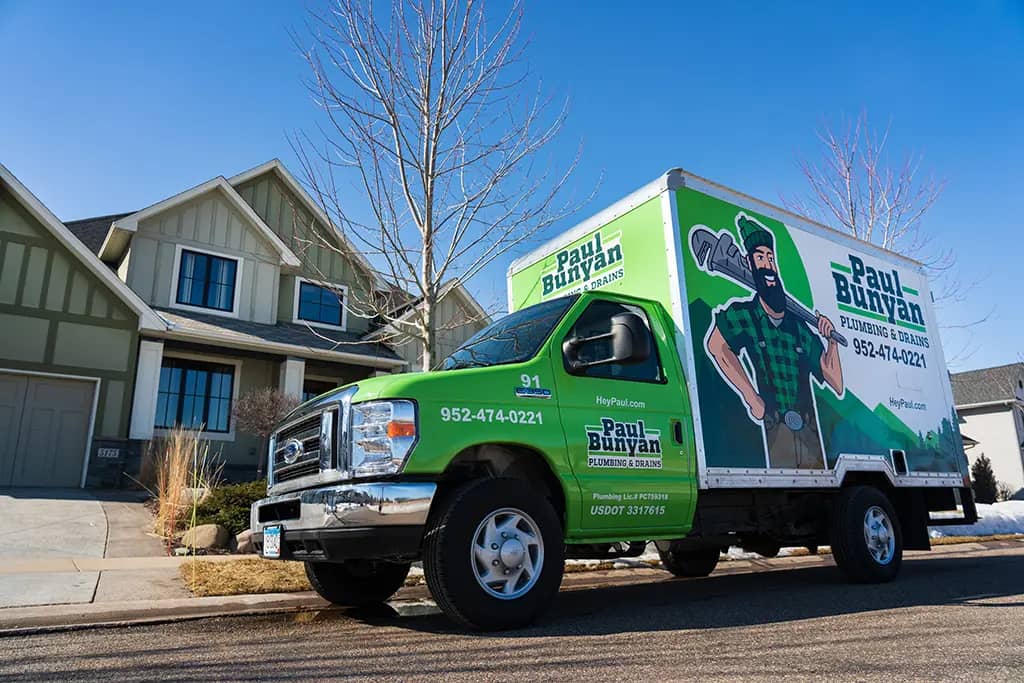Choosing the Right Trenchless Sewer Repair Company for Your St. Paul, MN Home
Though a building trade has been around for centuries, construction and renovation technologies are always evolving. Much like the evolution of medicine, in which invasive procedures are being replaced by ones that require less disruption and invasion, construction techniques look to limit collateral damage to the environment and building site.
One of the best innovations in plumbing is the advent of trenchless sewer repair. It offers a less invasive alternative to pipeline and sewer repair that typically requires excavation and large-scale restoration. Imagine the relative ease of replacing or repairing many feet of defective or outdated sewer pipes without excavators and backhoes tearing up your lawn or garden!
If you’re in the greater St. Paul, MN area and think your plumbing issues could benefit from trenchless sewer repair, contact Paul Bunyan Plumbing & Drains to learn more about this revolutionary new technique.
What Is Trenchless Technology?
As sewer pipes age, cracking and breaks can cause them to disintegrate. In some areas, the stress caused by tree roots can also destroy the pipes that lie beneath them. Traditionally, the problems caused by damaged or displaced underground sewer pipes were corrected by digging up and repairing or replacing each section of pipe as needed. But that was before trenchless technology became available.
Trenchless technology refers to a suite of techniques, materials and equipment most often used on underground piping infrastructure. As the name suggests, it is all about avoiding digging trenches. And it is welcome innovation in construction that can apply to plumbing repairs, and water line repair as well.
Trenchless technology all but eliminates the need for heavy equipment and the employment of a huge crew of equipment operators and spotters. Now, a single technician can dig a couple of small holes to prepare for sewer pipe replacement or repair. Micro video cameras and other diagnostic devices then allow personnel to work remotely from these small holes in the ground.
More and more utility contractors are using trenchless technology to service water and sewer mains and pipes, as well as other underground infrastructure, without major excavation. That’s because trenchless repairs are a relatively quick fix for contractors and can save homeowners a ton of time, money and disruption.
When Is Trenchless Sewer Repair a Good Option?
Certain scenarios are an especially good fit for the deployment of trenchless technologies to work on plumbing infrastructure. Much can depend on the condition of the ground surface, its stability and proximity to the water table. Popular situations for the deployment of trenchless methods include the following:
- in areas of high foot or vehicular traffic, it can be less chaotic to work around existing walk and roadways, rather than destroying and rebuilding them. It can also require extensive permitting and safety controls to inhibit the free access of any kind of traffic.
- in areas where commercial business could be disrupted, downtime and customer inconvenience can be avoided or kept to a minimum.
- in areas of environmental sensitivity, which could theoretically include a backyard full of mature trees, or plumbing infrastructure that tunnels under features like ponds, pools and gardens, trenchless sewer repair can minimize damage
- and in residential scenarios, where excavation is potentially costly, needlessly disruptive and complex, trenchless technology is becoming more of a sensible alternative
How Does Trenchless Sewer Repair Work?
Rather than dig up the driveway or yard to get at underground plumbing infrastructure, a qualified trenchless sewer repair technician will conduct the requisite diagnostics via video-camera, assess feasibility, and then use a compact directional drill to reach the site of the problem.
In some instances, new piping can be threaded through the old, eliminating the need for digging up and replacing the pipes.
In others, using quick set liquid resin solutions, trenchless technicians can cure entire new sections of pipe within the damaged line via small or even pre-existing entry points. The resin pipes typically used for patching routinely last up to fifty years.
The most expensive components of traditional, dig-and-replace pipe repair aren’t the materials or tools used, but rather the hard labor, displacement of earth, and long person-hours spent struggling to restore the repaired or replaced pipes. And then factor in the weather and working conditions, and making a site to safely work in. These extraneous costs are why traditional pipe repair typically costs 25-30% more than trenchless varieties.
Major Types of Trenchless Sewer Repair
Different styles of trenchless technologies involve direct kinds of equipment and techniques. A trenchless sewer repair plumbing service will assess which type is most appropriate for each situation. Here are the main types:
Horizontal directional drilling (often called HDD) – This is a trenchless method for installing relatively small pipes in lengths up to 600 ft or more from the surface of the earth. Types of pipes that can be installed include polyethylene (PE), polyvinyl chloride (PVC), steel and copper. Applications include water, gas and cable installations in soft ground.
The process involves creating a pilot hole, using mechanical cutting or fluid jetting tools, or a combination of the two, and then pulling the new piping through. It’s a highly efficient process. A mini-HDD system can be handled by a three-man crew with a small assembly of specialized tools. These systems can be used in backyards or alleys up to 100 feet from a power source. The locating and steering capabilities of the equipment allows tremendous control to avoid obstacles, and the disruption or destruction of the ground surface is usually minimal.
Micro-tunneling – This trenchless method is used for constructing new sewer pipelines. It involves the use of remotely controlled and laser-guided tools rather than simple exploratory digging by a human worker. Micro-tunneling systems can be used to install pipelines in a single pass, in lengths up to 1,500 feet or greater, in diameters in excess of 10 feet. The method also can be used in a variety of ground conditions from soft clay, to rock, or boulder ground, above or below the water table without having to dry out the work site. The method can be cost-effective compared to open construction especially when pipelines need to be repaired and installed in urban or suburban areas that may already be crowded with underground services. Micro-tunneling is also used in environmentally sensitive areas, in areas of unstable ground, or below the water table.
Pipe ramming and jacking – This method is commonly used in urban centers where the area immediately below roads or sidewalks often is crowded with existing services such as gas or telecommunications lines. Their presence allows little space for the replacement of a defective service with a new line. The pre-existing pipe or pilot hole in the ground can be valuable as a guide during replacement.
The technique consists of driving a casing or pipe through the ground using a pneumatic hammer. The hammer attaches to a casing, which is then driven through the ground by the hammer. Though it lacks the precision of micro-tunneling, it is ideal for installations or repairs under roads or railways, or for use when another technique such as HDD is stalled or obstructed.
Pipe bursting or pipe splitting – This trenchless method involves splitting a defective pipe and displacing the fragments to enable a new pipeline of the same diameter, usually of polyethylene, to be drawn in. In some cases, an expanding device, which may be either pneumatic or hydraulic, is introduced into the defective pipeline in order to shatter the pipe. Then a new line can be pulled through.
Your trenchless sewer repair repair specialist may not use all of these methods, but will likely have the materials and equipment for at least one, or something equivalent, in his toolkit. Although they sound like techniques to be used in large municipal or civic infrastructure projects, they are perfectly scalable to much smaller residential or commercial scenarios.
Your trenchless sewer repair repair specialist may not use all of these methods, but will likely have the materials and equipment for at least one, or something equivalent, in his toolkit. And although they sound like techniques to be used in large municipal or civic infrastructure projects, they are perfectly scalable to much smaller residential or commercial scenarios.
The Pros and Cons of Trenchless Service
The only real disadvantage to repairing sewer pipes using trenchless sewer repair techniques is that it is not always possible. Corrosion or old age can cause large sections of pipe to be unrepairable, making a fully excavated sewer line repair the only option. And in some communities, it can be difficult to access the services of a skilled trenchless sewer repair technician. However, if you live in the greater St. Paul, MN area, this will not be a problem.
Otherwise, there are significant pros to consider when trenchless sewer repair is presented as a possible solution to a plumbing problem.
- A trenchless sewer repair is usually completed within a day, which is one of the biggest advantages of this type of technology.
- Because there is minimal digging, little to no damage is done to your property. This can save thousands in reparation and landscaping costs.
- Trenchless sewer repair may be less expensive than the full cost of a traditional dig and the subsequent cost of restoration
How To Stay Safe During Trenchless Sewer Repair Service
Even a distance plumbing service such as trenchless sewer repair has been impacted by the global pandemic of 2020. Doing business with plumbing contractors require new safety protocols that involve both provider and customer. Any reputable business springing back into action will have them, including residential trades such as plumbing, so don’t be afraid to ask about safety and hygiene when you book a service call. Here are a few things to consider for keeping you and your family safe:
- In some jurisdictions, plumbing and other home repair specialists are exempt from stay at home restrictions. Trenchless projects are usually quite large projects and homeowners might consider delaying these types of service calls as long as possible. At the same time, no one should live with a potentially disastrous situation out of fear. If it’s to repair or replace a seriously damaged pipe, don’t hesitate to invite a professional repair person onto your property to set things right.
- Don’t hesitate to ask the service provider about the precautions being taken, and quiz the individual technician lead and crew making the call as well. Are they healthy? What is the company doing to ensure everyone stays safe?
- Prepare for the logistics of someone coming into or near the household from outside. Remind everyone in the household that they must retain 6 feet of distance from the plumbing technician at all times. Encourage family members to not watch the work, but to stay in another part of the home when a plumber is making a call. Open doors and generally clear a path so the plumber touches as few surfaces as possible. If all of the work is taking place out of doors, clear away any obstructions, prepare to move cars, and generally do everything you can to make the plumbers and crew’s job easier.
- Provide access to soap and water for proper hand washing. Your plumber will appreciate the gesture. If all work is outdoors, you could set up an ad hoc washing station with a garden hose.
If you own a home or business in the greater St. Paul, MN area and think your sewer pipe and plumbing issues could benefit from trenchless sewer repair, contact Paul Bunyan Plumbing & Drains of St. Paul, MN to learn more about this revolutionary new technique. They are the region’s experts for trenchless sewer repair and replacement and can explain how taking advantage of trenchless innovation can make even the most extensive sewer line repair or replacement job a fast and less expensive experience.


